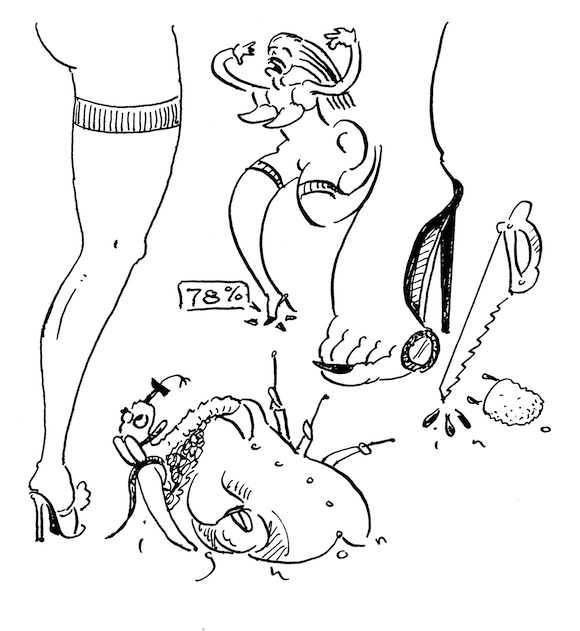
When I worked in the corporate world I had to wear mid- or high-heeled shoes. But now that I’ve changed jobs I get to wear flats, and in retrospect I don’t know how I ever put up with the discomfort of wearing heels every day. Several women I’ve asked said they’d read that high heels put 100 times more stress on your feet than flat soles. I know they hurt, but it’s hard to believe it’s that much of a difference. What’s the Straight Dope? — Debi, Kansas City
[hr_dotted]
On the scale of weird things women have done to themselves in the name of beauty, high heels surely come in well below foot binding, rib-crushing corsets, and bathing in crocodile excrement. (I found that last one on the Internet, so you know it’s gotta be legit.) I also acknowledge the scientific fact that high heels display the female form to advantage. That said, I thank the gods I’m male, because no way you’re getting me to wear those thumbscrews for the feet.
Before we get into the biomechanical specifics, let’s stipulate that, from a health standpoint, virtually everyone admits high heels are a scourge. I quote from an article in a law journal: “By one recent estimate, seventy-five percent of the problems eventuating in the more than 600,000 bunionectomies, hammer toe repairs, neuroma excisions, and bunionette corrections performed annually in the United States ‘either result from or are greatly aggravated by the use of high-fashion footwear.’”
And now to the lab.
Any wearer of high-heeled shoes knows the root cause of the discomfort is, in addition to (and compounded by) the unnaturally pointed shape of the typical shoe’s toe, the shift of weight to the front part of the foot. To quantify this, I turned to my assistants Una and Fierra. They obtained two identical scales and rigged up a system whereby they could balance with the front of their feet on one scale and the rear on the other. The ladies then raided their closets, found 33 pairs of shoes with heel rises ranging from a quarter inch to four inches, and put them to the test.
As expected, the higher the heel, the more weight was shifted onto the ball of the foot. When barefoot, an average of 68 percent of body weight rested on the heels. Athletic shoes shifted even more weight onto the heels — in the case of fencing shoes, an average of 77 percent.
But with a 2.75-inch lift the average weight on the heels had been reduced to 52 percent. With a four-inch lift only 30 percent of the weight was on the heels.
What we didn’t expect was the wide range in weight shift among different styles of shoes having the same heel height. For a three-inch heel, the share of weight on the heel ranged from 36 percent to 51 percent. Both women noted that shoes that kept more weight back on the heel were more comfortable. Of the shoes with significant heel lift, the least unpleasant typically had one or more of the following characteristics: (a) a relatively wide toe; (b) laces or a strap across the top of the foot, as opposed to the ankle, which prevented the foot from sliding forward in the shoe; or (c) uppers that enclosed the ankles entirely (these were boots, obviously), which likewise provided support preventing the foot from sliding forward.
The two women also noticed one significant difference between them, namely that Una generally tended to put more weight on the front of her foot than Fierra. Wearing the same style of shoe, with a four-inch heel, Una had 78 percent of her weight on the front end versus Fierra’s 68 percent — no doubt why Una’s feet hurt more in heels.
However, none of this backed up the assertion that high heels cause 100 times the stress of flats. Surely, we thought, we need to add motion to the equation. The pertinent equation here, of course, was force equals mass times acceleration, which on the face of it offered the potential to greatly multiply the shoe-wearer’s agony. The Straight Dope Bedroom of Science lacked the equipment to measure this, so it was back to the journals.
Alas, we were disappointed. The best we could find was a study comparing peak and total pressures on the plantar surface of 10 women’s feet while walking in low- and high-heeled shoes, using special insoles containing 99 sensors scanned at 10,000 times per second. Result: high heels on average increased peak pressure by about 32 percent and total pressure over time by about 48 percent. From this we deduce that the 100-times-the-stress claim is hype.
Never mind. The high-heel-wearer’s senses, to say nothing of all those needless bunionectomies, provide ample evidence of the consequences of slavery to fashion. We’ve known this for literally centuries, during which time countless other barbarous practices have been abandoned. Yet women still wear heels, and look hot when they do.
— CECIL ADAMS
Send questions to Cecil via straightdope.com or write him c/o Chicago Reader, 350 N. Orleans, Chicago 60654. Subscribe to the Straight Dope podcast at the iTunes.
